#art and cosmotechnics
Explore tagged Tumblr posts
Text

Yuk Hui will speak in CC de Belém on July 6th and in the Galeria Zé dos Bois on July 8th.
0 notes
Text
NOPE ASCII ART
▌─────────────────────────▐█─────▐ ▌────▄──────────────────▄█▓█▌────▐ ▌───▐██▄───────────────▄▓░░▓▓────▐ ▌───▐█░██▓────────────▓▓░░░▓▌────▐ ▌───▐█▌░▓██──────────█▓░░░░▓─────▐ ▌────▓█▌░░▓█▄███████▄███▓░▓█─────▐ ▌────▓██▌░▓██░░░░░░░░░░▓█░▓▌─────▐ ▌─────▓█████░░░░░░░░░░░░▓██──────▐ ▌─────▓██▓░░░░░░░░░░░░░░░▓█──────▐ ▌─────▐█▓░░░░░░█▓░░▓█░░░░▓█▌─────▐ ▌─────▓█▌░▓█▓▓██▓░█▓▓▓▓▓░▓█▌─────▐ ▌─────▓▓░▓██████▓░▓███▓▓▌░█▓─────▐ ▌────▐▓▓░█▄▐▓▌█▓░░▓█▐▓▌▄▓░██─────▐ ▌────▓█▓░▓█▄▄▄█▓░░▓█▄▄▄█▓░██▌────▐ ▌────▓█��░▓█████▓░░░▓███▓▀░▓█▓────▐ ▌───▐▓█░░░▀▓██▀░░░░░─▀▓▀░░▓█▓────▐ ▌───▓██░░░░░░░░▀▄▄▄▄▀░░░░░░▓▓────▐ ▌───▓█▌░░░░░░░░░░▐▌░░░░░░░░▓▓▌───▐ ▌───▓█░░░░░░░░░▄▀▀▀▀▄░░░░░░░█▓───▐ ▌──▐█▌░░░░░░░░▀░░░░░░▀░░░░░░█▓▌──▐ ▌──▓█░░░░░░░░░░░░░░░░░░░░░░░██▓──▐ ▌──▓█░░░░░░░░░░░░░░░░░░░░░░░▓█▓──▐ ▌──██░░░░░░░░░░░░░░░░░░░░░░░░█▓──▐ ▌──█▌░░░░░░░░░░░░░░░░░░░░░░░░▐▓▌─▐ ▌─▐▓░░░░░░░░░░░░░░░░░░░░░░░░░░█▓─▐ ▌─█▓░░░░░░░░░░░░░░░░░░░░░░░░░░▓▓─▐ ▌─█▓░░░░░░░░░░░░░░░░░░░░░░░░░░▓▓▌▐ ▌▐█▓░░░░░░░░░░░░░░░░░░░░░░░░░░░██▐ ▌█▓▌░░░░░░░░░░░░░░░░░░░░░░░░░░░▓█▐ ██████████████████████████████████ █░▀░░░░▀█▀░░░░░░▀█░░░░░░▀█▀░░░░░▀█ █░░▐█▌░░█░░░██░░░█░░██░░░█░░░██░░█ █░░▐█▌░░█░░░██░░░█░░██░░░█░░░██░░█ █░░▐█▌░░█░░░██░░░█░░░░░░▄█░░▄▄▄▄▄█ █░░▐█▌░░█░░░██░░░█░░░░████░░░░░░░█ █░░░█░░░█▄░░░░░░▄█░░░░████▄░░░░░▄█ ██████████████████████████████████
#ascii art#hack the planet#writers on tumblr#giovannachadid#cosmotechnics#malwaremedusa#bogota#art#ascii media works
3 notes
·
View notes
Text
NY / infinite dynamic horizons

infinite dynamic horizons May 14 – June 19, 2022 Artists and curator will be present at the gallery on Sunday, May 15 from 1-6pm
Tiger Strikes Asteroid New York is pleased to present infinite dynamic horizons, a two-person exhibition featuring the works of Charlotte G. Chin Greene and Sydney Shavers. The exhibition is SiSi Chen’s curatorial debut with TSA NY.
The notion of a horizon first became a fixture in the Western Art canon with the adoption of linear perspective in painting. This abstract proposal of flatness, where all things lead to one or more fixed points on a distant flat line, required one to be bound to an immovable position and accept this homogenous, calculable reinvention of time and space to be objective laws of representation. In her seminal essay In Free Fall: A Thought Experiment on Vertical Horizon, Hito Steyerl observes that with the ever-pervasive usage of Google Earth, AR/VR, and drone technologies, this horizontality is rapidly losing its place as the dominant perspective, replaced with one of verticality and its politics. Steyerl proposes that though this aerial perspective only grants some the god’s-eye-view of floating, but most the motion of perpetually falling, this free fall does not doom us to a demise of falling apart, and instead opens up possibilities of seeing the instability of the ground we are falling towards as vital for necessary shifting. infinite dynamic horizons asks the viewer to consider the horizon in endless motion, where one is constantly on the precipice of transformation, becoming and unbecoming virtual, into and through materiality, faced at once with itself and beyond itself.
Investigating the realms of planetary-scale computation, cosmotechnics, global industry and labor, Greene’s series of works probe the virtual as material. Fabricated from 3D-scans of hubcaps that the artist found while cycling throughout Philadelphia, the work compresses the circularity of viral, industrial, and temporal material. To Greene, this compression became ever more visible during the pandemic. Limited through the intermittent, stark, and repetitious space of Zoom, Greene witnessed their grandmother in her final stages of dementia, and eventual passing. The site-specific installation for this exhibition which accompanies these works activates interstitial space within the gallery through a recursive livestream video feed. Challenging conventional notions of the virtual as immaterial, the installation presents a link between networked hardware and the dis/orientation of the mind and body within nonlinear space and time. In their work, a horizon appears as not so much a fact of perspective as a proposal for the motion and distance between its own anticipation and memory.
This horizon as not-yet-here potentiality, discussed by José Esteban Muñoz in Cruising Utopia, allows for a forward-dawning futurity that extends beyond one’s own limited consciousness, viewable through affective excess. In her work untitled (sit 1-4), Shavers puts her viewers literally amongst the excess, where the chairs have merely suggestions of utilitarian function, and participation requires a negotiation with the horizon from one’s personal vantage point as a refusal of passivity. She creates a space for fugitivity, where implied relationship with a green-screen necessitates a grappling with disembodied signifiers, and opens up the possibility of what a beyondness through an unseeable horizon might be. Shavers’ ongoing performance work Rolling Hills, bridges this concept of thoroughness between the etymologies of performance and perspective, framing performance as an abstraction of living. What appears on the screen is an abstracted fragmentation of light recorded from daily sessions on a step-machine, a residue of performance, exertion, and fugitivity between body and machine.
Charlotte G. Chin Greene is an artist and curator based in Philadelphia, PA and New York, NY. They received their MFA in Sculpture from the Tyler School of Art & Architecture in 2021. Their research- and process-based practice studies time, machines, modes of sensing and perceiving, and the global flow of material. Solo and two-person presentations of their work include Remote Viewing, Temple Contemporary, Philadelphia, PA; Tack and Hide, Wick Gallery, Brooklyn; Red Work, Miranda Kuo Gallery, New York; Lamerica, Bible Gallery, New York; Anxiety Sex, Disclaimer Gallery, Brooklyn. Group exhibitions include Ghost in the Ghost at Tiger Strikes Asteroid, Brooklyn and writing about their work can be found in Artforum, The Brooklyn Rail, and Bedford + Bowery. Their recent curatorial project, I’ll Take Care Of You, is on view at Pilot+Projects in Philadelphia, PA.
Sydney Shavers is an artist based in New York, NY. Her work appraises preconceived notions & concepts of value. She uses deceptive camouflage to infiltrate systems both digital & ‘IRL’, and expose the ways power constructs understanding, mediates perception, and prescribes limits to reality. Her work has been exhibited nationally and internationally including We Were Already Gone at Hauser & Wirth; Manhattan NY; un/mute at the Austrian Cultural Forum New York, Manhattan NY; A Gathering at The Catskills in Tribeca, Manhattan NY; and Pieces of Me at Transfer Gallery & left.gallery [online]. Shavers has participated in projects & residencies including UN/MUTE 10002 with the European Union National Institutes for Culture & Undercurrent Gallery; The Interdisciplinary Art & Theory Program [NY]; & ACRE. Her work has been written about in Artnet News, Hyperallergic & The Art Newspaper. She has a BFA from the University of Illinois at Chicago & an MFA from CUNY Hunter College.
Tiger Strikes Asteroid’s programs are made possible by the New York State Council on the Arts with the support of the Office of the Governor and the New York State Legislature.



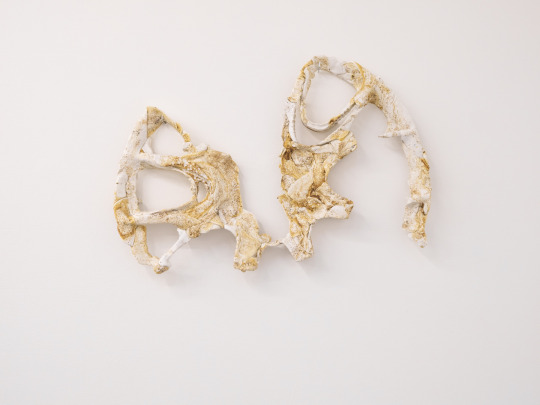
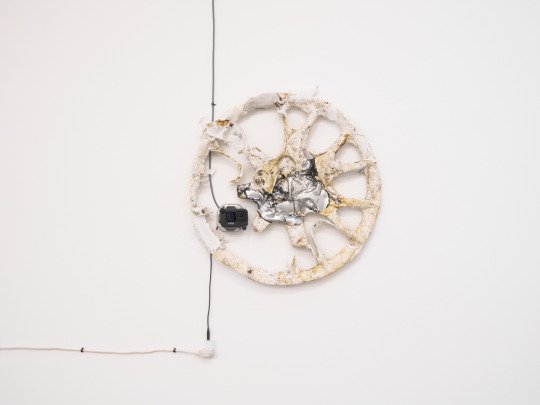

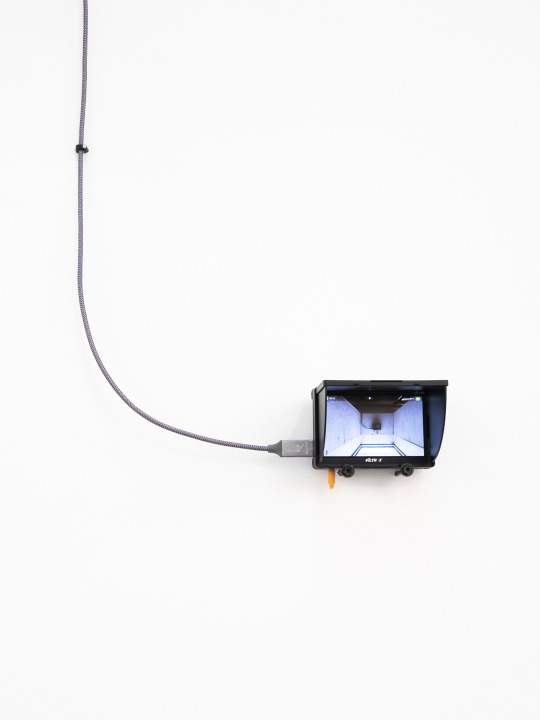
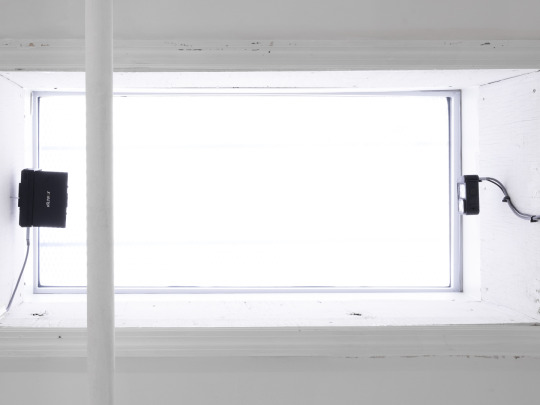

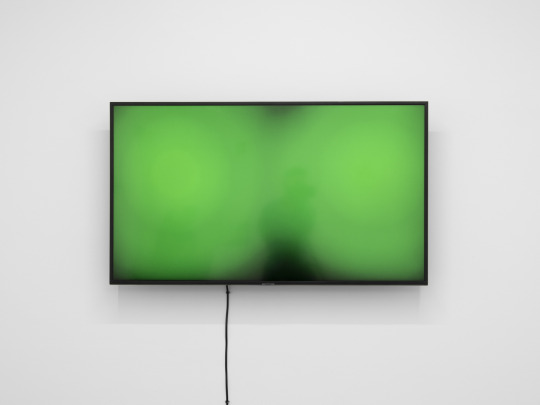
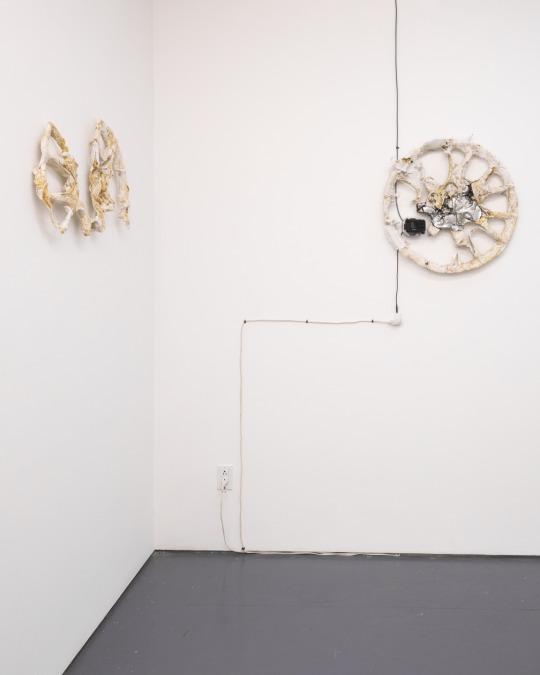
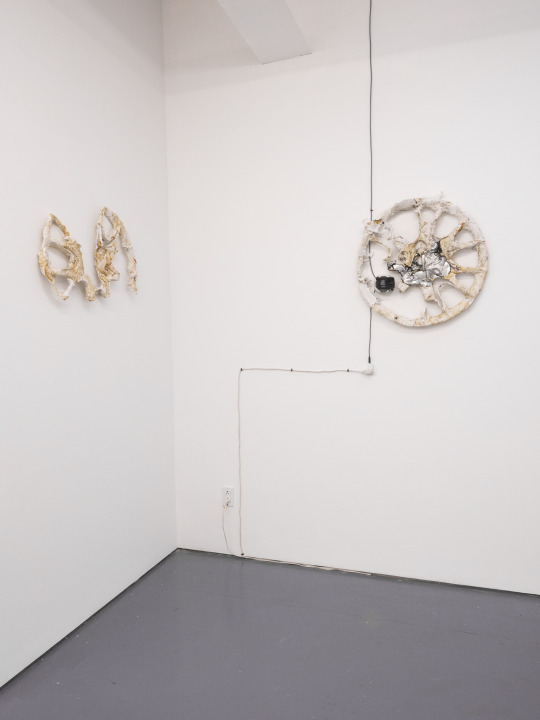


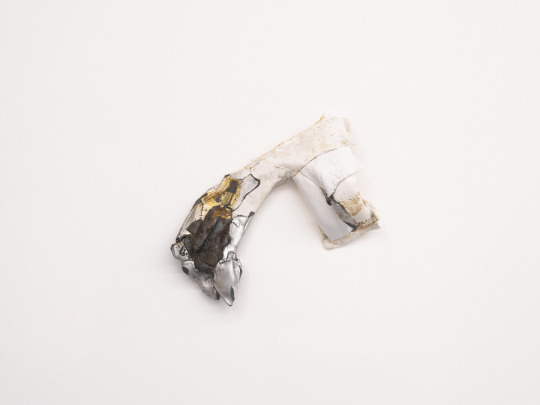
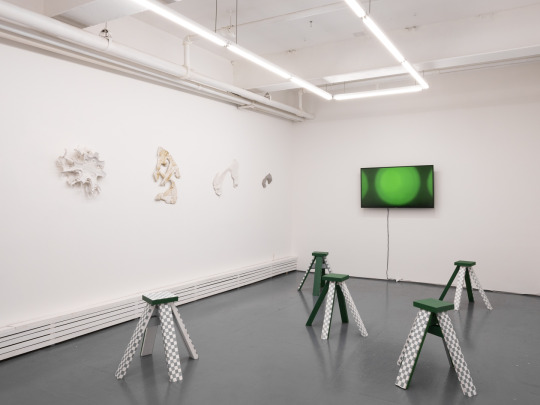

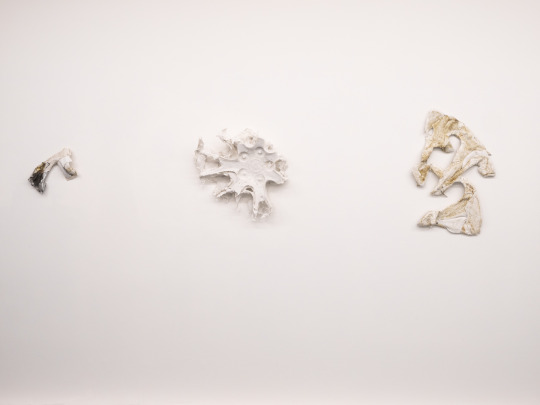

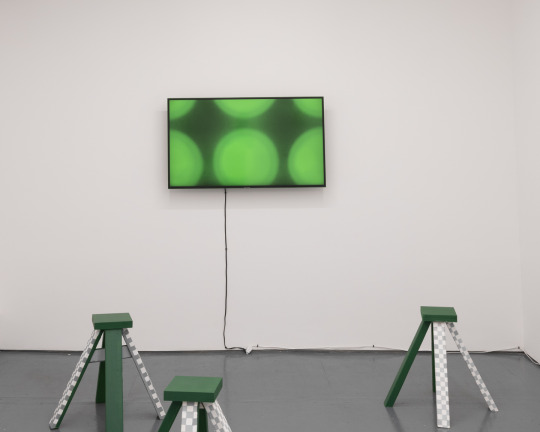









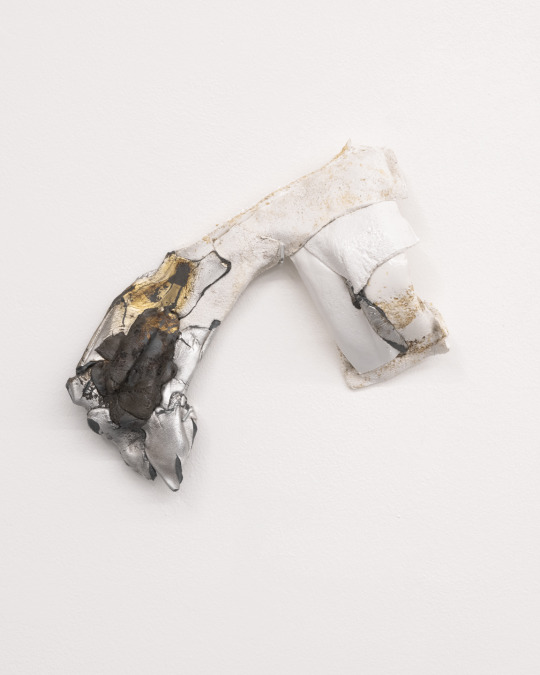
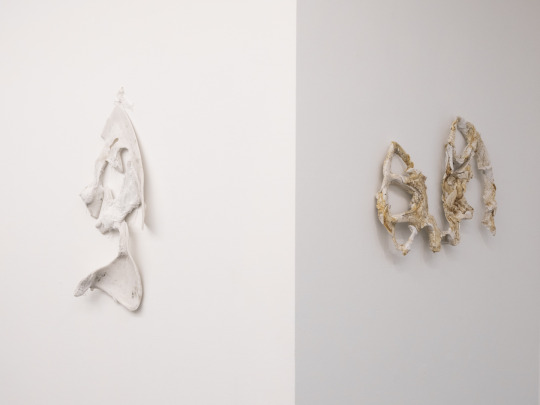

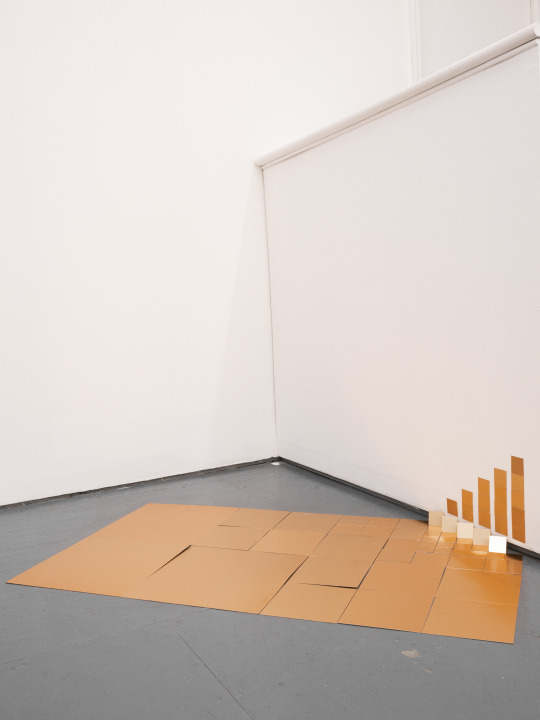


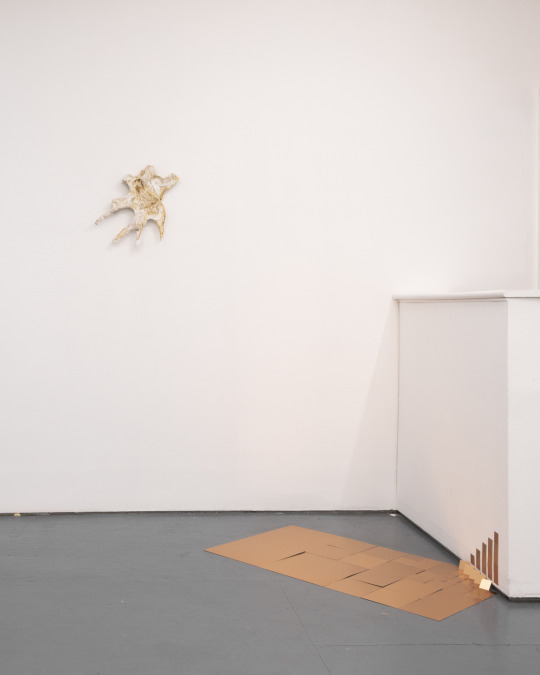

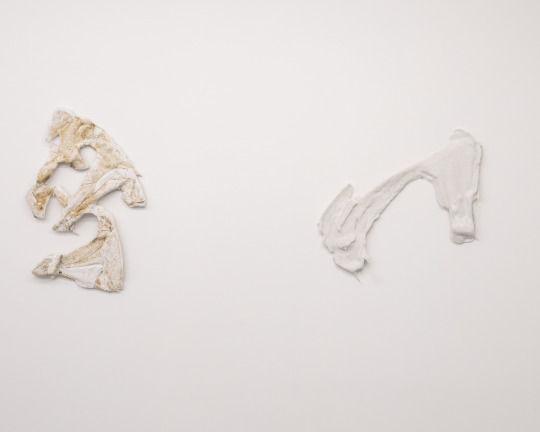
photos by Pacifico Silano
3 notes
·
View notes
Text
On Space Art by Xin Liu & Xin Wang
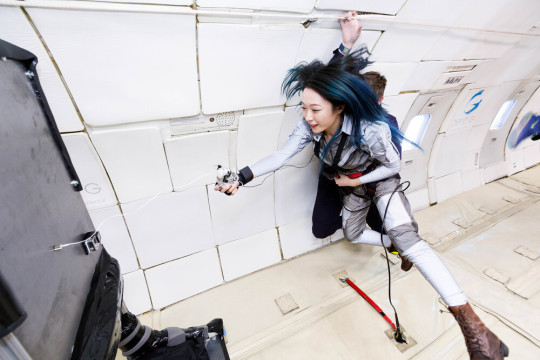
Xin Liu, Orbit Weaver, 2017. Production still of artist's performance during a parabolic flight. Image courtesy of the artist. Photo by Steve Boxell.
During the prolonged lockdown that defined much of 2020, the Xinjiang-born, New York-based artist and engineer Xin Liu juggled multiple roles. These included participating in a volunteering network that supplied PPE to medical workers in dire need of protection against Covid-19; designing an indie game, Sleepwalk (2020), which reflected on the conditions of confinement and hyper-connectivity; engineering a series of hypnotic sound experiences with her partner Gershon Dublon titled The Wandering Mind (2020), which guides the dreams of a sleeping audience with source materials organized by an AI system; and live-streaming an ambient soundscape recorded on Whitehead Island, off the coast of Maine, for the Camden International Film Festival.1
As the Arts Curator at MIT Media Lab’s Space Exploration Initiative and an artist who makes work for exhibition spaces, film festivals, and astronautical conferences, Liu’s ongoing fascination with space as a medium and destination for new art has seen her send a wisdom tooth into outer space, cultivate potato seeds that had travelled to the International Space Station, and imagine weightlessness as an intimate, “body-opening” condition. In this interview, we spoke about the past lives and expansive futures of Space Art, her unique mixture of academic and identitarian backgrounds, and the creative strategies of innovation and resistance while working at the juncture of art and technology.
Xin Wang: You’ve recently been referred to as a “famous space artist” in a panel discussion poster, which suggests that this is a solidified genre.
Xin Liu: It is a genre! If you google “Space Art,” there’s a Wikipedia page that defines it, though it’s very much about visual artists depicting the vision of space exploration, like images of Martian colonies, weightlessness, spaceships, etc. It was also called Astronomical Art, with notable artists such as Chesley Bonestell. These artists really tried to define the aesthetics of space, which even changed the way we would later color actual scientific images captured through different telescopes. Even now, if you look at NASA’s art programs, that’s still basically the main concept. Slowly it diverged into art in space, or art that uses space and environmental textures for creation, experimentation, and storytelling.
For me, Space Art conceptually connects more to Land Art in the seventies; the questions they were asking—regarding spatial-temporal dimensions and the way we engage with geological transformation—are more related. However, there is this jump in the Space Art medium from astronomical paintings right away to “art in space.” It is a gap in our understanding of Space Art; in my position as the Space Art curator at MIT, I have made sure to take into account Land Art, science fiction, and so on, in lectures.
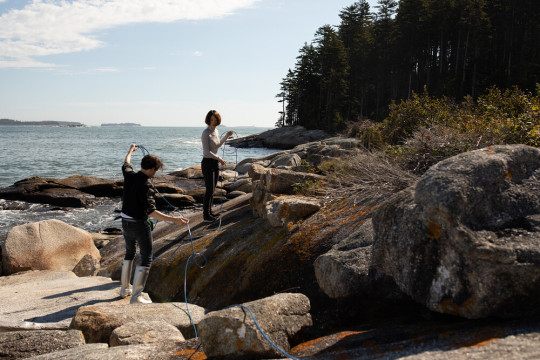
XW: What questions do you want to ask with your Space Art?
XL: First of all, the duality in our perception of the world: being a human being walking, eating, sleeping, drinking, and laughing on this planet; and on the other hand, knowing that we exist on a gigantic rock spinning around another hot rock in endless space. The epistemological jump is exciting but also problematic when we distance one from the other. People talk about science versus culture as if they are the polar opposites. I’m trying to reconcile the two views of the world and find places to live in-between. My other interest has more to do with the body, our sensations, our death, and the cycles of life and materials.
XW: Your works have always struck me as poetic—you sent one of your wisdom teeth into space in Living Distance (2019), which was inspired by childhood folktales and executed with robust engineering. But the whole debate around the idea that culture and science are antithetical has a long history. Susan Sontag wrote about it in the sixties, for example; what are you seeing in terms of new manifestations of, and challenges to, that tension?
XL: The philosopher Yuk Hui has proposed the concept of cosmotechnics, which argues that science and technology aren’t objective but are born of human cultures. One of my current projects, Unearthing Futures, is a collaboration with the Peruvian artist Lucia Monge, the International Potato Center in Lima, and the International Space Station (ISS).2 We are interested in potato history as human history; native to Peru, the potato’s journey becoming one of the most widely grown crops in the world mirrors colonial history. As we set foot and grow crops beyond the earth bond, one option here is to engineer the perfect potato that survives all conditions, while the other is to trust the possibilities of biodiversity, where a consortium of diverse species that are mutually dependent yields a higher chance of survival in extreme environments. Both are questions of science and technology, but at the same time they reflect philosophies—ones about how we survive.
We selected six varieties of native Peruvian potatoes with different characteristics, sent the potato seeds to the ISS to spend a month in microgravity, and exposed them to environment stressors such as radiation. The project has not grown potatoes in space, but it’s a significant step to understanding how environmental stressors affect thesis seeds. Having harvested the first generation in our respective studios, we plan to grow multiple generations and increase the numbers that we can process. Maybe in the fourth or fifth generation we can cook them and use them in workshops that involve the general public (we are working with public elementary schools in Portland) to think about the possibilities of food and agriculture in space exploration. Space potatoes are the protagonists in our stories and would facilitate these dialogues.
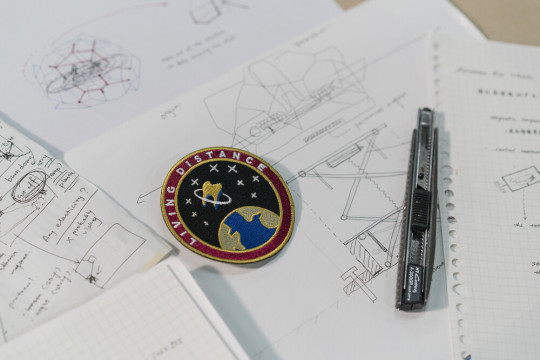
XW: When we were reviewing proposals for Sojourner 2020, an open call for artworks to be sent into low earth orbit by the MIT Media Lab Space Exploration Initiative, there were equally visible tendencies to flatten the crossover between art and technology into very gimmicky projects. In your position as both curator and artist working in this increasingly hyped juncture of art and tech, what are some of your goals and challenges?
XL: With the dropping costs of space launches and privatization, we are entering the New Space Age. Space Art is truly at the frontier now (no pun intended). There are many amazing art practitioners I’ve been able to invite to MIT and imagine together what this practice can be. The artist Agnes Meyer-Brandis, for example, created The Moon Goose Colony, where she trained geese on planetary science and different flight patterns to prepare them for the Moon.3 She even incubated and hatched the eggs herself. In 42-The Large Meteor T-R-A-P (2014), she uses electronic magnetic devices to guide the movement of meteorites, which can be viewed as a planetary defense system. In fact, the first planetary defense systems launched by NASA (the Double Asteroid Redirection Test) this past year also had to do with devices latching onto the meteorites to change their course of movement. I really like projects that are ambitious, beautifully executed, and which explore scientific possibilities as well as artistic ones. Unapologetically inserting yourself into other domains is also something I’m passionate about.
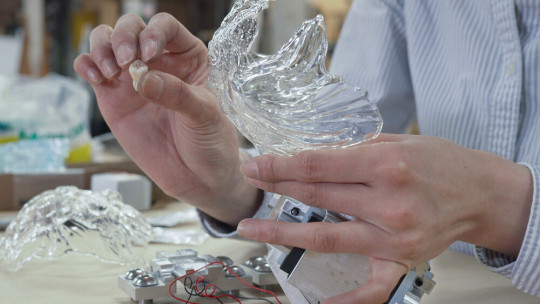
XW: What are some examples of such insertions?
XL: I recently had a conversation with the researcher Weng Jia, who looked into the detailed history of weather satellites beyond the pragmatics of weather forecast—itself a form of weather control that generates state power. It’s important to understand that history, but at the same time we can ask, as cultural producers, what now? We can either involve public engagement and sign petitions to request open access, or we can learn from the hackers—there are so many amateur enthusiasts who eavesdrop on state-owned radio signals, and through listening we are able to understand so much already. During the pandemic, my partner Gershon Dublon and I have tinkered with software-defined radio. Using just a tiny, 20-dollar USB dongle with an antenna we built from our clothing wires, we could receive the signals from retired National Oceanic and Atmospheric Administration (NOAA) weather satellites as they pass through the sky.
Even before the pandemic, my partner was looking into personal monitoring of air traffic, as most aircrafts have to broadcast their locations after reaching 18,000 ft. This was a fun plane-tracking activity at home. But later on we were put in touch with the Standing Rock Sioux tribe, who were protesting the Dakota Access Pipeline encroaching their territories. They were being illegally harassed and even sprayed with unknown chemicals by aircraft flying over their encampment, but couldn’t track the perpetrators. We helped them set up the aforementioned system using a computer, a 20-dollar dongle, and electrical metal wires, with which they were actually able to “see,” ID, and track the aircraft. Using that data and US Freedom of Information Act (FOIA) requests, the water protectors were able to pursue their harassers and hold them accountable. Is it art practice? I think it’s important and exciting to examine the “wall”; there’s no wall that’s perfect—there are always cracks. You can find things between the breaks and slowly percolate, and, in a way, take back those powers—I found those processes most exciting.
XW: I think this is a powerful approach that counters the general pessimism towards big tech, technocratic states, and surveillance to the point that people don’t even want to think about the possibilities of cracks.
XL: But that’s a facade, and I don’t know who marvelously crafted it. A lot of these things, such as the radio, are not so complicated. Given a week and the internet, most people can figure it out; it’s not rocket science. You know who is most interested in amateur radio nowadays? The fifty-plus generation, sometimes grandpas. There is a big community in Staten Island in New York. However, in the arts, these systems and disciplines are rendered unfathomable, which prohibits further investigation. That’s the problem.
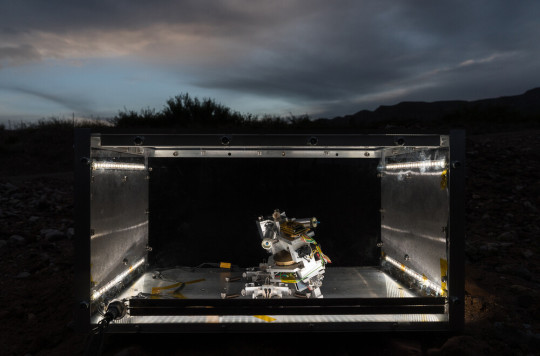
XW: When you were speaking about “the cracks in the wall” earlier, I had a very dark thought—in the future, planetary warfare will look drastically different and be much more deadly than the wars currently taking place on Earth.
XL: Future wars may not be quite so physical as we imagine—the virus is a powerful model for what could happen. It shows how fragile and resilient humans are; cyberattack, trade wars, geoengineering manipulation of nature—these are all struggles on different planetary scales, and we have to constantly self-educate as citizens and decode what the decision makers are actually saying.
XW: You received your undergraduate training at Tsinghua University, which is known for its rigorous focus on scientific training and as a place that has groomed many of China’s top technocratic leaders. It’s also considered the Chinese counterpart of MIT, where you completed a graduate program. How do those experiences compare and inform your trajectory?
XL: When I was in Tsinghua, I studied mathematics, physics, and mechanical engineering; my degree was in precision instruments. Nowadays I still practice them in my sculpture in its manufacturing and fabricating processes. It’s a craft. I later went to Rhode Island School of Design (RISD), not because I wanted to be an artist, but out of a sad realization. In China, we separated art and science education since high school, and my liberal arts education was limited.
It was a selfish desire to study fine arts after college just to become a “complete” human being. I am very grateful that my parents didn’t disapprove this decision. At the time I told myself that I’d probably still end up working for Google and Microsoft; I had interned at both places during graduate school, thinking that’s how I would make a living eventually. But those two years were transformative and gave me an absolutely new way of looking at the world. Even graduating with an MFA from RISD, I still couldn’t commit a hundred percent to being a professional artist, as it is really difficult financially. I’m a practical immigrant. I had to figure out a way to stay in the country and feed myself. Then I went to MIT, because it was fully funded and I had the luxury to do research; after another two years in school, I decided that I wanted to work freely, and “artist” is the title that offers the most freedom.
XW: Do you still believe that?
XL: I do. If you tell people you are an artist, whatever you do doesn’t surprise them as much. It’s harder to talk about sending a tooth to space as a physicist.
XW: I’m struck by the way you describe gravity as a “momentum of feelings” on your website.
XL: That’s something I was thinking about when I first experienced weightlessness in 2017, during a parabolic flight. The plane literally free-falls in the sky, and in reference to the cabin, everything inside the plane is weightless. I had a bit of a performance background in dance. The experience was shocking: there was no “free from gravity”—gravity is always there. It was just everything falling together. The experience was less about me floating or flying than about the ground beneath me dropping. It’s not liberating in the way that you are accelerating and going up, which is what we associate with space exploration probably, but rather a kind of letting-go and descending. It was an eye-opening—body-opening—experience for me, and a bitter-sweet moment as well.

XW: Speaking of bodies and embodiment, do you find this excessive attention to—often performances of—an artist’s identity shows up more or less or differently for you, given the curious juncture of disciplines and identities you inhabit?
XL: It depends on who is seeing me. The tech aspect of me can seem alarming to people who are used to traditional practices, and in the so-called media/tech/science art world, gender might manifest more. The audience decides who I am. My name reads as gender-neutral in both English and Chinese. Sometimes people assume I’m a man initially, because I’m working with technology; but a bit more engagement with the work might compel one to realize that I could be a woman, because of the way I deal with technology. Still deeper into it, you might realize I’m Asian.
Another interesting aspect comes from the fact that I don’t just participate in art events; I also present my works at the International Astronautical Congress (IAC), where it’s just pleasing to see my portrait—that of a young Asian woman—next to attendees that are largely from different demographics. And I enjoy that—inserting myself in different systems. It’s not just gender, but also geographic. I am an outlier in many ways—I went to a military-affiliated high school, so the instinct to fit in was strong growing up. But here, as people of color and women, we naturally stand out and have more identities. It could be tiring but it’s also our power—meaning that we can potentially empathize with more people. People like you and me—when we talk about America in a positive light in China or criticize the Chinese government, we are perceived as brainwashed by Western liberalism; but when we talk about Chinese companies like WeChat positively here, or the effective Covid-19 responses and technological innovations in China, we’d be considered brainwashed in the other direction too.
XW: I always feel that exposure to different systems of brainwash leads to utmost clarity. What do you think the future of space art will be, or what you hope it could be like?
XL: I think it will mature like digital art, bio art, internet art, AR/VR art—all these sub-domains. I read extensively on space policies, which obviously figure prominently on many nation states’ agendas. At the IAC conference in 2020, eight national space agencies just signed the Artemis Accords, which is an international agreement on the principles for corporations and civil explorations for the moon, Mars, comets, and asteroids. Particularly notable is the encouragement and protection for private entities to participate in the future of space exploration, and its effect on commercial activities will be significant; even the ISS is going through a commercialization process already. Space will become more commercial and privatized; it will engender more conversations and force us to be involved and investigate the industry.
XW: What’s your favorite Space Art piece?
XL: I was struck by Ilya Kabakov’s The Man Who Flew Into Space From His Apartment (1985) when I first knew about it. I have been (and am still) confined in my apartment due to the pandemic. It is the absolute desire to break the ceiling and get out. Though both are heading towards outer space, the Soviet campaign in space exploration and a personal desire to leave, to be free, cannot be more different. In fact, one is defeating the other.
_____________________
Xin Liu (b. 1991, Xinjiang/China) is an artist and engineer. She is the Arts Curator in the Space Exploration Initiative in MIT Media Lab, a member of New INC in New Museum, and a studio resident in Queens Museum. She is also an artist-in-residence in SETI Institute and the recipient of numerous awards and residencies.
Xin Wang is a curator and art historian based in New York. She is currently planning an exhibition that explores Asian Futurisms for The Museum of Chinese in America, New York. While pursuing her PhD in art history at the Institute of Fine Arts, New York University, she’s also been conducting a series of public zoom webinars on topics of technology, new media, and Asian American perspectives for the Whitney Museum of American Art since spring 2020.
Source: https://www.art-agenda.com/features/372727/on-space-art
2 notes
·
View notes
Photo

HyperBody Dungeon: UCCA Edge, Mixed media installation: pneumatic membrane, cloth flag, dodecahedron plaster mold, VR equipment and computer, Shanghai, China, 2022
Commissioned by UCCA Center for Contemporary Art
This work was made in cooperation with the architect Liu Binbin. The artist would like to thank "With in/out Linhai" artist residency program, Tian Fengyuan, Xu Ziyi, Hao Jianguo, Wu Jingzhi, Zhang Boxiao, and grannysmilkproductsplant for their assistance and support.
/
HyperBody Dungeon: UCCA Edge is a mixed-reality architecture rooted in the Sculpture Garden. It includes the inflatable structure "MULE (Mobile Utility Lunar Excavator)’s Drop Pod Mod" and three video game levels "Garden Portal", "Stratholme.GoStop", and "Project Search". The architecture as a whole signals gamespaces and in-game items intermediating physical and virtual boundaries, and the players are invited into an audio-visual spatial experience of "multi-fandom cosmotechnics".
HyperBody Dungeon: UCCA Edge integrates multiplayer online and single-player offline VR game levels. Multiplayer online levels mediate virtual and physical space, link online and offline; via the entanglement of physical and virtual, single-player offline VR levels delve into ACGN (animation, comics, games, and novels) fandoms and explore urban space, culture, technology, and Chinese cultivation novel.
"Garden Portal" is a 3D scan mod of the Sculpture Garden. In it, players are encouraged to find the portals to "Stratholme.GoStop" and "Project Search".
"Stratholme.GoStop" is a Chinese fan-made visual novel game based on Warcraft. The story takes place in the welfare zone of Ordnance Factory 404, two junior high school students meet in an internet bar and prepare for the tournament. Through their entanglements between real life, study, and the game world, they become involved with the narrative of game protagonist Alsace’s culling of Stratholme. As the tournament nears, another untold killing happens...
"Project Search" is a visual novel game based on Chinese science fictions and cultivation novels. The story takes place in the old town of Linhai. The collapse of two ancient pagodas on Jinzi Mountain reveals the exploration of parallel dimension and the underground grotto-heaven. Qian Jiangmin, a young scholar who has just recovered from a serious illness, travelled through Dunhuang and Chongqing to Linhai to look for his brother. With the help of various scholars and Dao cultivators, he enters the underground grotto-heaven in Linhai old town. As he explores further, the space-time of the ancient city shifts... Qian Jiangmin also realises why he has double vision...
1 note
·
View note
Text
Theory Threads // Reflecting on Fictioning as Practice
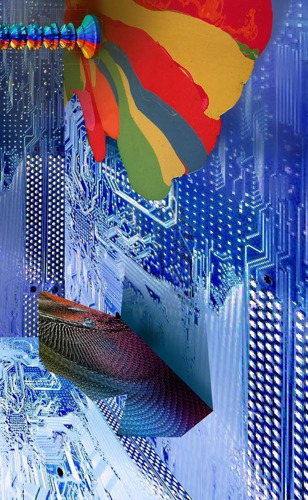
Notes and thoughts that took their final form in a 20-minute talk at the TVAd Symposium at Hertfordshire University:
The idea of computational fictioning, or more precisely looking at computation from the lens of speculative realism, science fiction and weird science. Adopting the concept of hyperchaos as a central theme and explore its weight within the art sphere and its relevance to methodology.
In After finitude Quentin Meillasoux introduces theis notion of hyperchaos as a new way of looking at the world and he defines it as both the absence and presence of disorder, and in this quality of a concept that denies contingency, it brings forward the idea that anything could change in time. Determination and chaos are the same, in the sense that they are both governed by laws. They produce different effects but disorder in itself is a type of order different from the “order of things” that we are used to. He goes further to define imagination as a manifestation of hyperchaos into the thought realm, of disorder appearing into order.
Through this dual quality of hyperchaos, it is essentially almost an ungraspable concept. Eugene Thacker describes a similar conception in his writings on the horror of philosophy. It’s worth noting that Thacker approaches the concept of horror not as a category of the literary or filmic but rather as a “privileged site” for the unthinkable grey areas where philosophical glitches occur. And he attributes this idea of the unthinkable to the world - for him, the increasingly changing hyper objects we are faced with today (Time, Space, Earth, Climate) are becoming increasingly hard to disseminate. The effort to grasp their magnitude means an effort to go beyond traditional ways of thinking.
To further explain this ontology of the unthinkable, he defines two instances of the world : the word-for-us, the world manifested in human thought, and the world-in-itself, the world outside of human cognitive capacity. But he also defines a third world existing in a liminal space, a spectral, speculative world that is the world without us, or the nonhuman world, a world existing as we know it but without a human element - this brings in an interesting look at the world of the nonhuman, that which we perceive to exist but that is not us. He exemplifies these worlds as Earth for the world for us, World as a general concept for the world in itself and the Planet as the world-without-us, a choice that bleeds into the concepts of hyperobjects and cosmotechnics.
And in thinking of this idea of a spectral world, of the grey areas where the nonhuman and the incomprehensible might find themselves; thinking about “weird science”, a science that concerns itself with the objects and phenomena previously left out of traditional science approaches. Lisa Blackman defines the category of the anomalous as a signifier for these speculative worlds, and this notion of the anomalous can be further linked to the proliferation of data today - data in itself bears symbolic and imaginary qualities and histories that are often occluded, its often haunted, as Blackman suggests, by the excess of its own storytelling - Blackman defines those concepts pertaining to the anomalous as the “incomputable” within the real, but I would like to argue that precisely computation can create affordance for these anomalous beings to exist. Today “we live with data, imagine with data, feel with data and even anticipate futures, and it only makes sense for data to play a role within speculative practices.
In discussing these notions of speculative practices, I’d like to bring forwards the idea of fictioning. First theorised by Donna Haraway as fabulation, it references a practice that is concerned with speculation around future human and nonhuman modes of existence. Simon O Sullivan then builds a framework around this idea, claiming that we need to approach fiction not as a literary category but rather as a verb, as in the act of fictioning. Fictioning in this sense of an activity is paramount to artistic practice - or any practice involving the use of imagination - we can think of any art form as a portal into a fiction, a different time, a different state of things, an alternate reality that means to reveal something to its audience.
Robert Smithson begins to flesh out this idea of fictiong as artistic methodology by claiming that that which the artist seeks is the fiction reality will sooner or later immitate - an interesting link can be created here between the act of fictiong and intervening into reality.
And we are to circling back here to Meillasoux and the concept of hyperchaos, specifically in relation to time. He claims that hyperchays is a theory of times theory. To show that time is not becoming, but rather that becoming is a case of time. This brings a chronological dimension into attempts to explore hyperchaos artistically, and suggests the idea that anything that is imagined may come into being in a certain time frame. The science fiction writer W Gibson discusses this at the concept of “atemporality”, the idea that because the proliferation of technology today all eras exist at once. And this for me is a central concept in discussing fictioning as methodology, as fictions have the power to traverse timescales, existing outside of the present.
This idea that everything is a possibility, so anything that is imagined may come into being in a certain time frame bleeds into what Meillasoux identifies as the production of little worlds with absolutely no becoming, a creation of microcosms that embody Thacker’s notion of the world-without-us, worlds with no becoming within the realm of thought.
In terms of integrating such notions into art practice we are faced with the question of how the artist can figurate something like hyperchaos?
Meillasoux starts fleshing out a pathway by exemplifying that “the painter has to show transcendence but he can’t just show it, he can just make an analogon of transcendence”. And this concept of this analogon as a sort of symbol of the incomprehensible is tightly interlinked to the the idea of the anomalous. Where the anomalous is the realm of existence, the analogon is the manifestation in the comprehensible world; we have to present in the limited scope of what can be presented - one cannot show IT, but we can show its direction, we can provide a form of rational access.
And this brings me back to fictioning, and specifically science fictioning understood again as verb, as action rather than Genre. Simon O Sullivan identifies 3 strands within the practice of fictioning, and I will be discussing two of them here in relation to science fictioning as methodology: myth-science, or the practice of constructing alternate prospects and models and mythotechnesis, concerned with the future influence of machines. And it is particularly this idea of the machine that can be harnessed to explore what Deleuze calls “the seeds of the people to come”.
When differentiating between the real and fictioning, Deborah Levitt reduces these concepts to questions:
When faced with the real world, we ask ourselves “WHAT”?
Whereas when faced with incomprehensible or the imaginary the question is “HOW”?
0 notes
Text
“We live in an ocean of air”, other gallery visits, artist research and ideas for titles.
I went to see the interactive virtual reality exhibition “We live in an ocean of air” today. It left a deep impression on me with its flocking branches, swarms of particles forming branches, breath and foliage. It reminded me of an ancient tree with deep roots and energy running through its veins. This was analogous to the processes present in all life. Networks of branches and roots formed as you swirled in the space.
youtube
I also went to see Bill Viola and Michelangelo at The Royal Academy. I was struck by the elemental aspects of the work, as these were relevant to my own practice. There were videos of people underwater breathing, the image of them rippling, with bubbles rising. The bubbles and water travelled upwards and the images rippled when underwater. Fire was reflected in the water. The reflection line dividing some of the images had bubbles travelling away from the line, and ripples distorting the image. I found the portrait video works with fire or bubbles travelling upwards especially interesting. Perhaps similar imagery could be the starting point for some of the graphics for my work.
vimeo
Norimichi Hirakawa | datum, 2017, Moerenuma Park, Sapporo, Japan from norimichi hirakawa on Vimeo.
Norimichi Hirakawa’s digital works are chaotic and glitchy generative pieces, but their form and colour schemes are sometimes reminiscent of nature or the cosmos. This is work that could inspire the graphical aspects of my work in progress.
Related to my interest in using tai chi in my work is the Malay rituals art archive. It has video documentation of many different dances and rituals used in Malay culture. It also has a lot of image documentation of traditional performance forms such as Mak Yong Malay dance drama, and Teochew puppetry.
Possible titles for my essay could be:
“Exploring an elemental classification of internet and geotechnologies through five Cosmotechnical fables” or “Five Cosmotechnical fables exploring the Chinese environment through an elemental classification of technology”. One possible idea would be to maybe use Google Earth data in imagery for the work in progress piece.
References:
http://counteraktiv.com
https://vimeo.com/user14378708
https://medium.com/digital-art-weekly-by-danae-hi/18-museums-boosting-the-scene-of-digital-art-f8a4b4fa5eb9
https://www.pusaka.org/
https://joanielemercier.com/projects/
0 notes
Text
Below is my Project Proposal (initially submitted on the 24th January)
Contents: 1,500 Words
•Overview
•Creative research
•Techniques, technologies, materials
•Existing knowledge / New knowledge
•Basic prototype
•Timeline & Milestone
Following the formation of the Etherstrike Collective in the recent UCU strike action, I want in my final project to work with a Raspberry Pi to create a local private internet server, curated digital library, and archive, as part of a larger sculptural installation. I envision this piece as a dispersed seedling/permutation of the ambitious and meaningful work of the Bibioteca collective and the Experimental Publishing Masters course of the Piet Zwart Institute. In the creation of this final piece, I hope to work with and combine technical, creative, and conceptual areas of my interests and study.
Conceptually, I want to bring together – into combination and inter/intra-action – some of the knowledges, critical theory, and beliefs that I have encountered and grown from and with over the past two and a half years. For me, this means I particularly want to involve and draw from: ecologies of knowledges, symbiogenesis and symbiosis, multispecies collaborations and living (making kin), geologic (deep) time, archival and collective memories, agential realism, and magick and spirituality (particularly informed by ancient (specifically – because of how I am personally situated – European Pagan) knowledges and ways of life). My hope is to explore, through creative experimentation, some of the relationships, juxtapositions, and tensions present in the bringing together of these vast and far-reaching ideas and themes. This imagining is intentionally interdisciplinary and open, so as to allow myself space and time to intuit, learn, and explore throughout this process, but I intend to connect these themes in the creation of a piece which ultimately focusses on (questioning) realities of climate, ecological, and civilisational collapsings.
Recently spending time in the process of writing my dissertation – on the significance and potential roles of speculative imaginings in and through climate and civilisational disturbances and collapsings – I’ve grown increasingly interested in ideas of seeding and sowing worlds, taught and inspired particularly by Octavia E. Butler (‘Parable of the Sower’), Ursula K. Le Guin (‘The Dispossessed’, ‘The Carrier Bag Theory of Fiction’), Anna Lowenhaupt Tsing (‘The Mushroom at the End of the World: On the Possibility of Life in Capitalist Ruins’) and Donna Haraway (‘Staying with the Trouble’). Understanding how I am presently situated, with the resources and skills I am structurally privileged to have available to me, I want to present these ideas materially through imagining technological-forms-as-seeds. By this, I mean: considering the ways in which these worlds and stories, which we are of, have unfolded and are unfolding now – with the sixth planetary mass-extinction event currently happening – I want to experiment with technological forms which might be able to be practically supportive through conditions of collapse.
I’m therefore very interested in ideas and practices of knowledge sharing, communication, and archival, with active anti-capitalist, anti-racist, intersectional, “autonomist” politics as their foundations; I want to grow and co-create work which seeks to help to ungate critical and powerful knowledges, with the intention of opening up spaces of encountering and collective resistance. What knowledges, resources, and recorded stories/memories/worlds, may be necessary and/or helpful in these conditions? At a core of this piece, I want then to build from the tension between how the work may be pragmatically useful and meaningful now, and how it might be useful or meaningful (if at all) in its (/our) futures. I want to consider how these technological forms might continue to exist and live – with or without human or animal company/ionship – and imagine the symbol of the dispersed seed as highly relevant and integral to this speculative exploration.
I want – ultimately – for my art practice (and for this work, as part of my practice) to contribute to undermining and challenging exclusionary and oppressive systems and institutions. I hope in this work to provide myself with the space to experiment and learn technically, and then – from this – to really explore what it might mean to curate forms of knowledge when considering (crucially) my own positionalities, and our collective relationships with one another, nonhuman species, deep time, and – ultimately – Earthlife.
In this way, I basically am intending to program myself the platform through which my artwork is contained and communicated. I am not yet specifically clear on how exactly I want an audience to engage with this work, though I wonder about the possibility of this “seed”’s contents being viewable when connected to it via the private network that it supports. Perhaps its contents – curated knowledges, eg. books, visual art pieces which I have collected, collaged, and created, celestial/land//water maps, magickal symbols, scientific projections of future conditions, …, etc. – could then be downloadable. My concerns with this idea, though, are accessibility and sustainability: perhaps I will decide through the creative process, with these concerns in mind, that I am instead more interested in creating a piece which has to be connected to physically in some way(s) in order to be accessed. Alternatively, perhaps the Seed’s contents might be displayed through other visual mediums, arranged around the installation piece itself. Something that I am also very interested in potentially exploring through this work is presenting this curated information via a talk / performance. One of my main priorities is communicating what I have been privileged enough to learn in ways that are accessible, whilst simultaneously creating a piece which is aesthetically and conceptually meaningful and engaging.
Aesthetically, I also have allowed myself, at this point, the openness to explore, but below are some of my initial sketches and imaginings. I’m fascinated by the symbolism of the ancient Celtic Tree of Life, which they worshipped and believed embodied natural harmony and balance, representing the power of connection – how many trees grow together and communicate, forming forests. I am also very interested in and inspired by amber in this project – I am amazed by the processes of living matter becoming fossilised over millennia, and in this the formation of “time capsules” which carry (and then can tell of) alternate and ancient worlds. As is apparent, my aesthetics are very much informed by my conceptual understandings and interests, and I hope in my piece to work with living forms, or representations of living forms, which can draw an audience in and speak to our innate inter+intra-connectedness. Trees, roots, plant-life, mushrooms, mycelium formations, fungi, slime mould, moss, rock, soil, earth, water, fire, air, animal-boroughs, spider-webs, the web of life, and on… I anticipate that actually perhaps one of my main challenges in this piece aesthetically will be in learning how I want to – and how it is possible to – bring this inter+intra-connection into an exhibition space.
As well as the writers/researchers and their books listed above, I’m also wanting to learn and draw from ‘Emergent Strategy: Shaping Change, Changing Worlds’ by Adrienne Maree Brown, ‘Meeting the Universe Halfway: Quantum Physics and the Entanglement of Matter and Meaning’ by Karen Barad, ‘Magic’s Reason: An Anthropology of Analogy’ by Graham M. Jones, ‘A Paradise Built in Hell’ by Rebecca Solnit, and ‘Cosmotechnics as Cosmopolitics’ by Yuk Hui. I am hoping to shape the confluence of these influences and ideas. I intend to dedicate my time and energy to the technical foundations of my piece from the outset, hoping to then be able to follow my learning, interests, and ideas more creatively as the process goes on and draws towards the exhibition itself. Programming the Raspberry Pi and setting up the server will be my first responsibility, and will involve following the Etherbox Manual and what I am learning in/with the Etherstrike Collective.
0 notes
Text
Post-exhibition thoughts and future directions
vimeo
The Subalterned Shan Shui from Helena Wee on Vimeo.
My interactive installation “The Subalterned Shan Shui” utilised traditional Chinese landscape paintings which, using style transfer, were changed into city-like scenes. To do this I used night city scenes as style images, and created five different landscape pairs. The interaction utilised a Kinect which detected the viewer’s position. The position determined the percentage of the picture that was styled, so when people walked in front of the projected landscape it would change from one of five traditional paintings, to a styled cityscape-like version of it.
In front of the projected landscape there is a circular screen showing two rotating double Calabai Yau manifolds. Their vertex positions are affected by Bitcoin price. The spiral tightens or expands according to viewer position, its changes mirroring those in the landscape behind it.
The piece examined environmental issues relating to technology and China. Bitcoin mining is prevalent in China and uses cheap mainly coal-based electricity which contributes to climate change. The Three Gorges Dam was built in area of outstanding natural beauty, now affected by landslides. Such landscapes were traditionally the subject matter for Shan Shui style painting.
I used Cosmotechnics and Chinese philosophy to look at the environment and technology. Chinese “Shan Shui” or “Mountain, Water” paintings depict natural landscapes referencing Taoist concepts such as paths, the threshold and the heart. The 5 elements were referenced in the 5 different scene pairs – wood, fire, earth, metal and water. As an elemental form within String Theory, the Calabai-Yau manifold serves as an analogy for the flowering of Qi and Dao in balance with a moral cosmotechics (Yuk Hui).
The Subaltern as an idea was initially proposed by Gramsci and elaborated on by Spivak referencing those without agency or a space of difference within the current hegemonic power structure (Capitalism). In this piece I was proposing landscape and the environment generally as being subaltern. In some ways I also suggested technology was subaltern, perhaps as a tool of the current power axis.
The main aim of the piece was to look at these ideas and propose that the audience decide where the balance between landscape and technology is or should be. However I was also quite happy for alternative interpretations of the piece to occur. Feedback included praise for the concept and comments about how it was a multilayered work. Some people did not realise Bitcoin mining’s effect on climate change, and felt I should have made the Bitcoin aspect more prominent. Some people felt my ideas were good but not clear enough.
Being in an interactive exhibition a few people thought that the circular screen was an interactive touchscreen of some sort. Some people had trouble seeing what was on the small screen due to the glare from the projector. Experimentation with different optimsers or inceptionism might have produced different landscape images. Experimenting with changing the Calabai-Yau form with data in a different way might have been interesting.
Broad future directions and current areas of research include Unity, data programming and shaders. Conceptually I have been developing research into Bitcoin and climate change and looking at Taoist rituals and prayer. Artists of interest include Zadie Xa’s Taoist inspired embroidered artworks1, Sarah Meyohas’ “Bitchcoin” project2, Andy Bauch’s “New Money” series of works that are lego images which are keys to cryptocurrency wallets3 4 5, and Julian Oliver’s work “Harvest”2.
In “Harvest” a sensor-equipped wind turbine is connected to a weatherproof computer mining a lesser-known cryptocurrency called Zcash (using renewable energy). A live video feed showed data visualization of the wind turbine and the computer setup. Any money earned was donated to climate change research. Outside of initial setup and occasional monitoring, no humans were involved. Oliver describes it as a “funding automaton”. He doesn’t see the Blockchain as utopian. Instead he sees it as a digital public evidence gathering platform.
Possible future directions include researching more about the materiality of Btcoin and the Blockchain. Performative aspects of Bitcoin and relating it to cosmotechnics. Looking at predictive text and cosmotechnics. Envisaging Bitcoin as a narrative rather than just a source of data, and looking at other cryptocurrencies.
References
1. https://www.zadiexa.com/
2. https://news.artnet.com/art-world/cryptocurrencies-artwork-explainer-part-two-1215707
3. http://uk.businessinsider.com/kevin-abosch-cryptocurrency-artwork-yellow-lambo-2018-4?r=US&IR=T
4. https://gizmodo.com/artist-hides-secret-code-to-10-000-worth-of-cryptocurr-1824030024
5. https://www.nytimes.com/2018/06/05/arts/design/cryptocurrency-blockchain-art-kevin-abosch.html
https://www.coindesk.com/chinese-artist-ai-weiwei-uses-ethereum-to-make-art-about-value/
https://www.furtherfield.org/blockchain-geometries/
Book: Artists Rethinking the Blockchain
0 notes
